Best Carpet Grass Varieties for Lawns, Parks, and Playgrounds
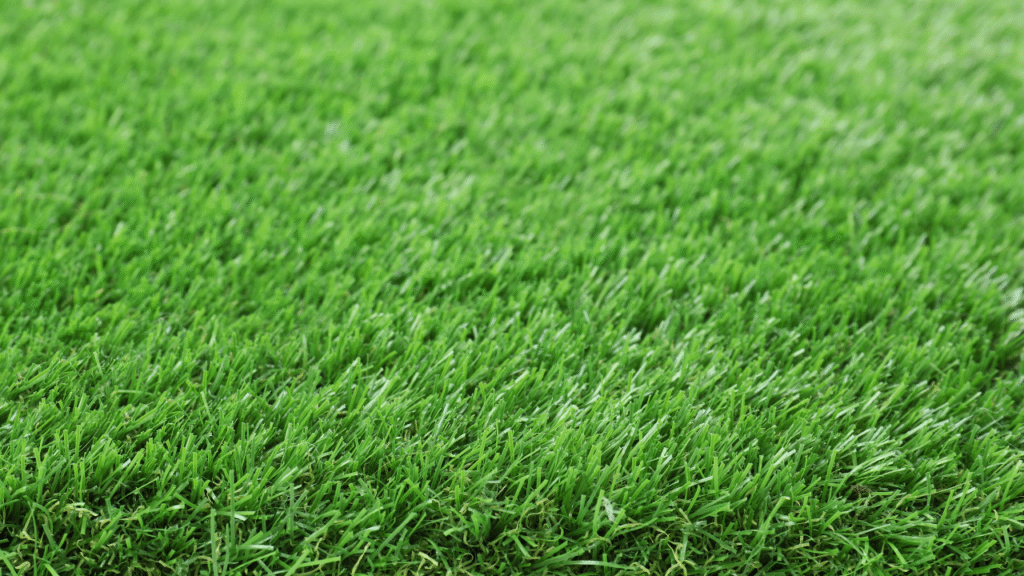
Have you ever walked barefoot on a lush, green lawn and felt like you were stepping on nature’s softest carpet? That’s the magic of carpet grass! Whether it’s for your home garden, a public park, or a playground where kids run and play, choosing the right carpet grass can completely transform the area. Not only does it enhance the aesthetic appeal, but it also improves soil health, reduces dust, and provides a safe, soft surface for play.
With so many grass varieties out there, picking the perfect one can feel overwhelming. Should you go for something low-maintenance? Or a grass that can withstand heavy foot traffic? In this article, we’ll explore the best carpet grass varieties for lawns, parks, and playgrounds, along with tips on planting and maintenance. By the end, you’ll know exactly which grass suits your space and lifestyle.
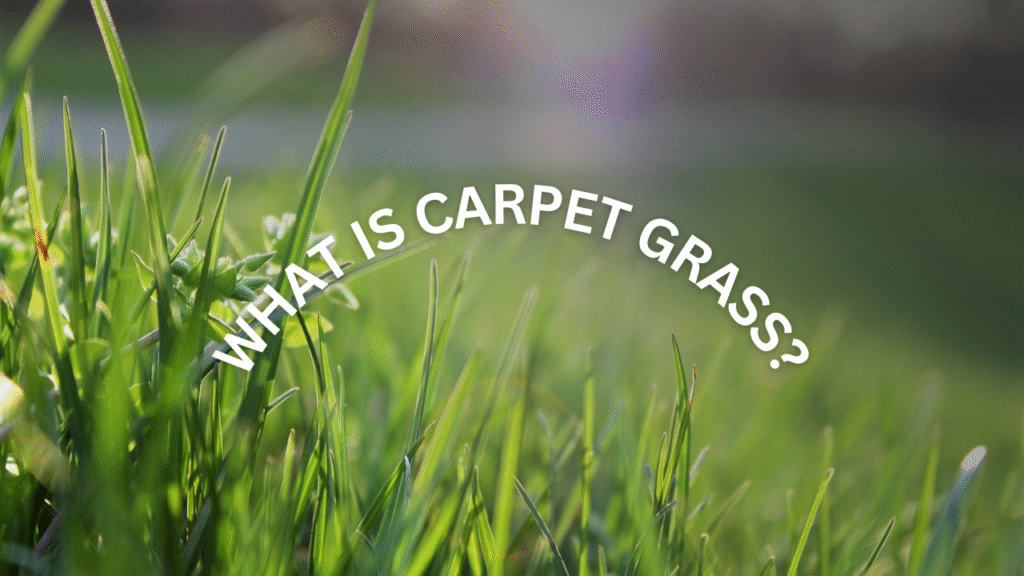
What Is Carpet Grass?
Carpet grass isn’t just any grass it’s a type of turf that forms a dense, low-growing mat, almost like a natural carpet over the soil. Unlike other grasses that grow in clumps or patches, carpet grass spreads uniformly, making it ideal for lawns, parks, and recreational areas.
Difference Between Carpet Grass and Other Lawn Grasses
While some grasses are tall and ornamental, carpet grass is all about coverage, durability, and low maintenance. Think of it as the difference between a fancy area rug and wall-to-wall carpeting both look nice, but only one protects the floor everywhere. Carpet grass protects soil, resists weeds, and provides a soft, uniform surface, making it perfect for kids, pets, and outdoor activities.
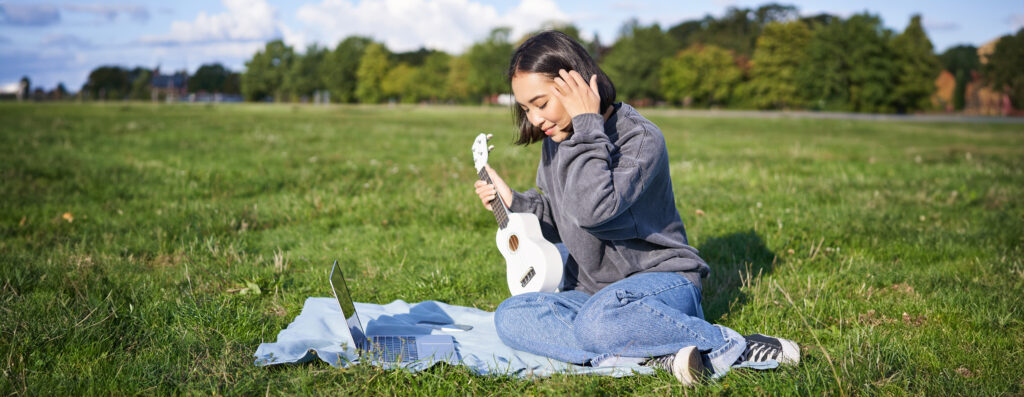
Key Factors to Consider When Choosing Carpet Grass
Selecting the right carpet grass isn’t just about picking the greenest variety it’s about finding the one that perfectly matches your environment, lifestyle, and how you plan to use your lawn or playground. Before you buy, it’s smart to understand a few key factors that directly affect your grass’s growth, appearance, and longevity. Let’s look at them in detail.
Climate Adaptability
Every grass type has its own comfort zone when it comes to weather. Some love the tropical sun and heat, while others thrive in cooler or partially shaded areas. For instance, Bermuda and Kikuyu grass grow best in hot, sunny climates, while Zoysia and St. Augustine can tolerate a bit of shade.
If you choose a grass that doesn’t match your local climate, it may struggle to grow, resulting in patchy coverage, brown spots, or excessive maintenance. So, always check your region’s temperature range, humidity levels, and sunlight exposure before making a choice. Remember, a well-matched grass type means less work and a healthier, greener lawn year-round.
Maintenance Requirements
Some people love tending to their lawns every weekend, while others prefer a “plant it and forget it” approach. That’s why maintenance needs should be one of your top considerations.
If you have a busy schedule, go for low-maintenance grasses like Buffalo or Zoysia, which need minimal mowing and watering. However, if you enjoy grooming your garden, Bermuda or Kikuyu might be great since they grow faster and respond beautifully to regular trimming and care.
Low-maintenance doesn’t mean no maintenance even hardy grasses need occasional fertilization, watering, and weeding to stay healthy. The goal is to pick a variety that suits your time, lifestyle, and climate without overwhelming your routine.
Wear and Tear Resistance
If your lawn is a high-traffic zone think kids playing, pets running, or people walking often durability is a must. Not all grass can handle constant trampling.
Grasses like Bermuda, Kikuyu, and Zoysia are built tough. They have strong root systems that allow them to recover quickly from damage, making them ideal for parks, playgrounds, and sports fields. On the other hand, delicate varieties like Buffalo grass might not bounce back as quickly after heavy use.
Always assess how much activity your space gets. A good rule of thumb: the more the foot traffic, the tougher the grass you’ll need.
Growth Rate and Coverage
Growth rate determines how fast your lawn becomes lush and full. Fast-growing grasses like Bermuda can cover bare patches quickly, making them perfect for new lawns or freshly landscaped areas. However, they often need frequent mowing and trimming.
In contrast, slower-growing types like Zoysia or Buffalo take more time to spread, but once established, they form thicker, more uniform coverage that naturally resists weeds.
If you’re after instant results, sodding with fast growers may be your best bet. But if you’re patient and prefer a low-maintenance, long-term solution, go for slower growers that build strength over time.
Pest and Disease Resistance
A beautiful green lawn can quickly lose its charm if attacked by pests, fungus, or diseases. That’s why it’s smart to choose grass varieties that are naturally resilient to your region’s common problems.
For instance, Zoysia and Buffalo grass tend to resist most pests and lawn diseases. Meanwhile, Bermuda grass, though popular, may attract certain insects or fungal spots if overwatered. The trick is to balance proper lawn care not too much moisture, adequate sunlight, and good soil drainage with the right variety selection.
Opting for disease-resistant carpet grass doesn’t just save time and effort, it also reduces chemical use, making your lawn safer for pets, children, and the environment.
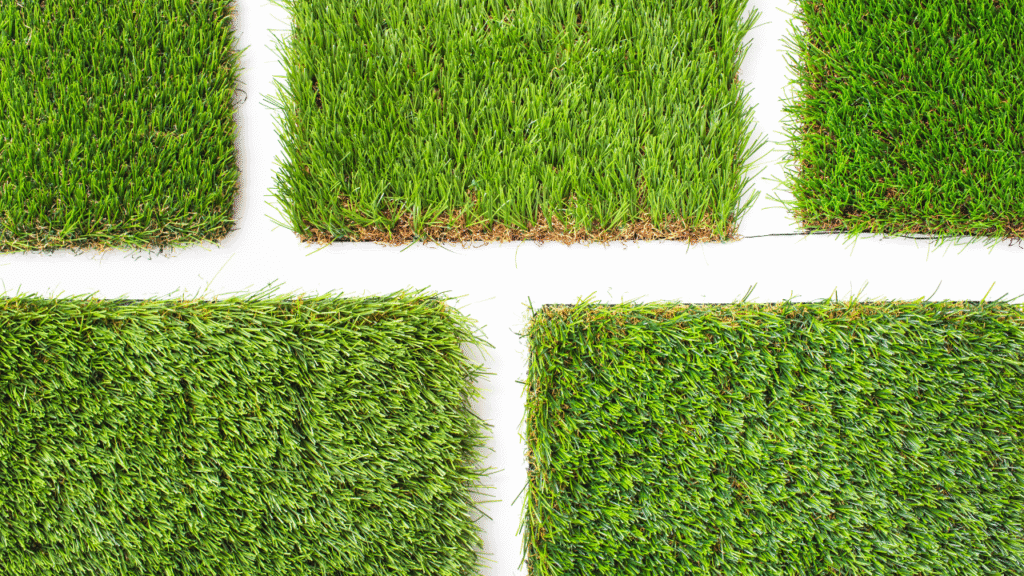
Top Carpet Grass Varieties for Lawns, Parks, and Playgrounds
Bermuda Grass (Cynodon dactylon)
Characteristics and Appearance
Bermuda grass is one of the most popular choices for lawns, parks, and playgrounds because of its hardy nature and attractive look. It has fine, green blades that grow close to the ground, creating a thick, carpet-like surface. This grass spreads quickly through both stolon’s (above-ground runners) and rhizomes (underground stems), which helps it cover bare patches effortlessly. It thrives best in full sunlight and can tolerate high temperatures, making it ideal for India’s warm and tropical climates. Once established, Bermuda grass forms a resilient turf that stays lush and green throughout the growing season.
Ideal Usage Areas
Bermuda grass is perfect for parks, playgrounds, golf courses, and sports fields because of its excellent wear tolerance and fast recovery from damage. Even after being trampled or played on, it quickly bounces back, maintaining a neat and uniform appearance with minimal effort.
Pros and Cons
- Pros: Fast-growing, drought-tolerant, durable under foot traffic
- Cons: Needs full sun, requires regular mowing
Zoysia Grass (Zoysia species pluralis)
Characteristics and Appearance
Zoysia grass is a premium choice for those who love a soft, carpet-like lawn that looks stunning throughout the year. It has fine to medium-textured blades that grow tightly together, creating a dense and uniform surface. Its growth pattern is slow but steady, which means it doesn’t require frequent mowing a big plus for busy homeowners. The grass has a beautiful emerald to light green colour that remains vibrant during warm months. Zoysia also spreads through both rhizomes and stolon’s, helping it fills empty patches over time.
Ideal Usage Areas
Because of its lush appearance and durability, Zoysia grass is perfect for lawns, parks, golf courses, and home gardens where aesthetics and comfort matter. It thrives in sunny areas but can tolerate light shade, making it suitable for a variety of Indian climates. Its low water and maintenance needs make it a favourite among eco-friendly gardeners.
Pros and Cons
- Pros: Low maintenance, tolerates moderate traffic, drought-resistant
- Cons: Slow to establish, can be expensive to buy
Buffalo Grass (Buchloe dactyloides)
Characteristics and Appearance
Buffalo grass is one of the most popular warm-season lawn grasses, admired for its soft texture, natural green shade, and drought resistance. Native to the Great Plains of North America, it thrives even in areas with low rainfall and high temperatures, making it a perfect choice for Indian climates with dry summers. The blades are fine and curly, creating a smooth, carpet-like surface that feels comfortable underfoot. Unlike some fast-growing grasses, Buffalo grass spreads slowly through stolon’s, forming a dense, weed-resistant turf over time. It requires minimal mowing and watering, making it an eco-friendly and low-maintenance option for homeowners and park managers alike.
Ideal Usage Areas
Buffalo grass is best suited for lawns, parks, golf courses, and playgrounds located in dry or semi-arid regions. Because of its exceptional drought tolerance, it’s an ideal choice where water conservation is essential, ensuring greenery even with minimal irrigation.
Pros and Cons
- Pros: Very low water requirement, hardy, low mowing needs
- Cons: Less wear-resistant, slower to recover from damage
Kikuyu Grass (Pennisetum clandestinum)
Characteristics and Appearance
Kikuyu grass is a vigorous, fast-growing warm-season grass known for its bright green colour and dense, carpet-like coverage. It spreads quickly through both rhizomes (underground stems) and stolon’s (above-ground runners), helping it fills bare spots with ease. Its medium to coarse-textured blades creates a soft yet durable lawn surface that feels pleasant underfoot. This grass thrives in sunny, tropical, and subtropical climates, making it a great choice for regions with high temperatures. It has excellent drought tolerance and recovers rapidly from wear or damage, maintaining a lush, green appearance throughout the growing season.
Ideal Usage Areas
Kikuyu grass is ideal for playgrounds, sports fields, golf courses, and public parks where there’s constant movement and foot traffic. Its fast regrowth ability makes it perfect for high-use areas that need quick recovery. Additionally, its vibrant colour and thick texture enhance the beauty of residential lawns and large landscapes, ensuring a lively and refreshing look all year long.
Pros and Cons
- Pros: Fast establishment, excellent wear tolerance
- Cons: Can be invasive if not managed, needs frequent mowing
Perennial Ryegrass (Lolium perenne)
Characteristics and Appearance
Perennial Ryegrass is one of the most popular cool-season grasses, known for its fine texture and bright green colour. It has soft, glossy blades that create a smooth, velvety look, making lawns appear neat and attractive. This grass germinates and establishes very quickly often within 7 to 10 days, which is why it’s widely used for overseeding existing lawns to improve thickness and colour. It performs best in cool, temperate regions and stays green even in mild winters. However, it prefers well-drained soil and regular watering to maintain its lush appearance.
Ideal Usage Areas
Perennial Ryegrass is perfect for lawns, parks, sports fields, and playgrounds that experience moderate use. Its fast growth allows for quick recovery from wear and tear, making it great for active spaces. Because of its soft feel and vibrant colour, it’s also a favourite choice for decorative lawns and home gardens in cooler climates.
Pros and Cons
- Pros: Fast-growing, soft texture, great for overseeding
- Cons: Requires regular watering, not very drought-tolerant
St. Augustine Grass (Stenotaphrum secundatum)
Characteristics and Appearance
St. Augustine grass is known for its broad, coarse blades that create a thick, carpet-like lawn with a rich green colour. It spreads through above-ground stolon’s, forming a dense turf that naturally crowds out weeds. One of its best features is its excellent shade tolerance, making it a popular choice where other grasses struggle to grow. The blades are slightly coarse to touch but give a soft, cushiony feel underfoot. It thrives in warm, humid climates, maintaining its vibrant green hue throughout most of the year when properly cared for.
Ideal Usage Areas
St. Augustine grass is ideal for residential lawns, coastal areas, and tropical or subtropical climates such as those found in southern India. It performs well in partially shaded lawns, gardens surrounded by trees, and areas with moderate foot traffic. With regular mowing and watering, it stays lush, resilient, and visually appealing all year round.
Pros and Cons
- Pros: Shade-tolerant, dense growth, soft feel
- Cons: Sensitive to cold, higher water needs
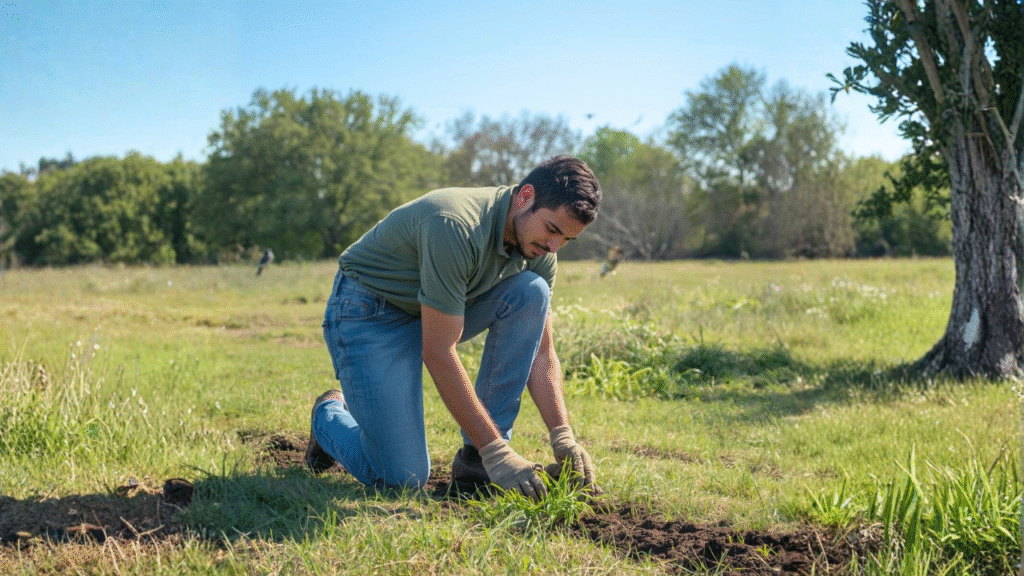
How to Plant Carpet Grass Successfully
Planting carpet grass might sound simple, but getting that lush, velvety lawn requires a little planning and care. From preparing the soil to maintaining the right watering routine, each step plays an important role in how healthy and beautiful your grass will look. Let’s go step by step to make sure you plant it the right way.
Soil Preparation
Before you even think about sowing seeds or laying sod, the most important step is preparing the soil. Carpet grass thrives best in well-draining, nutrient-rich soil. If your soil is hard or clay-like, loosen it up using a garden tiller or spade. This helps air and water reach the roots easily.
Next, remove all weeds, rocks, and debris from the area. Weeds compete with young grass for nutrients and water, which can slow down the growth process.
To boost soil health, mix in organic compost or aged manure. This not only adds essential nutrients but also improves soil structure. Ideally, the soil pH should be between 6.0 and 7.5, which is slightly acidic to neutral the perfect range for most carpet grass varieties like Bermuda, Zoysia, and Buffalo grass.
Finally, level the soil surface using a rake. A smooth, even surface helps the grass spread uniformly and prevents water from pooling in one area.
Seeding vs. Sodding
When it comes to planting carpet grass, you have two main options: seeding or sodding. Each has its own benefits depending on your budget, timeline, and the size of the area.
- Seeding:
This is the more affordable method and great for large areas like parks or playgrounds. You simply spread the seeds evenly over the prepared soil using a broadcast spreader. Then lightly rake the soil to cover the seeds about ¼ inch deep and water gently. The only downside? It takes a few weeks for seeds to germinate and fill in the space, so patience is key. - Sodding:
If you want instant results, go for sod. Sod is basically pre-grown grass rolled into sections that you lay directly on the soil. It creates an immediate green carpet and reduces the risk of erosion or weed growth. However, it’s more expensive and requires good initial watering to ensure the sod roots properly into the soil.
Both methods can yield great results it just depends on your timeline and budget.
Watering Schedule
Watering is one of the most crucial parts of establishing a healthy carpet grass lawn. When the grass is young or freshly sodded, it needs consistent moisture to help the roots establish firmly.
- For the first 2 to 3 weeks, water lightly but frequently ideally once in the morning and once in the evening.
- Once the grass starts rooting (you can test by tugging gently it should resist), you can reduce the frequency but increase the depth of watering. This encourages deeper root growth, making your lawn more drought-tolerant in the long run.
Avoid overwatering, though. Constantly soggy soil can cause root rot and invite fungal diseases. The goal is to keep the top few inches of soil moist, not waterlogged.
Fertilization Tips
Healthy grass needs nutrients just like we need a balanced diet. After your grass starts to establish, begin a regular fertilization schedule to promote lush growth and vibrant colour.
Use a balanced lawn fertilizer ideally something like NPK 10-10-10 or 16-16-16, which provides equal parts nitrogen (for green colour), phosphorus (for root development), and potassium (for strength and disease resistance).
Apply fertilizer every 6–8 weeks during the active growing season usually spring and summer for warm-season grasses like Bermuda or Kikuyu, and autumn for cool-season types like Ryegrass.
Always follow the label instructions carefully. Too much fertilizer can burn the grass and harm soil microbes. Water your lawn immediately after fertilizing to help nutrients soak into the soil and avoid leaf burn.
For an eco-friendly option, you can also use organic fertilizers like compost tea or vermicompost. These not only feed your grass but also improve the soil’s natural health over time.
Extra Tips for Successful Planting
- Timing matters: The best time to plant carpet grass is during its active growing season spring for warm climates and early autumn for cooler areas.
- Avoid foot traffic: Keep kids, pets, or heavy objects off the lawn until the grass has rooted firmly.
- Mulching helps: A thin layer of organic mulch can retain moisture and protect seeds from washing away.
- Test before you start: A simple soil test from a garden center can tell you if your soil needs lime, fertilizer, or amendments.
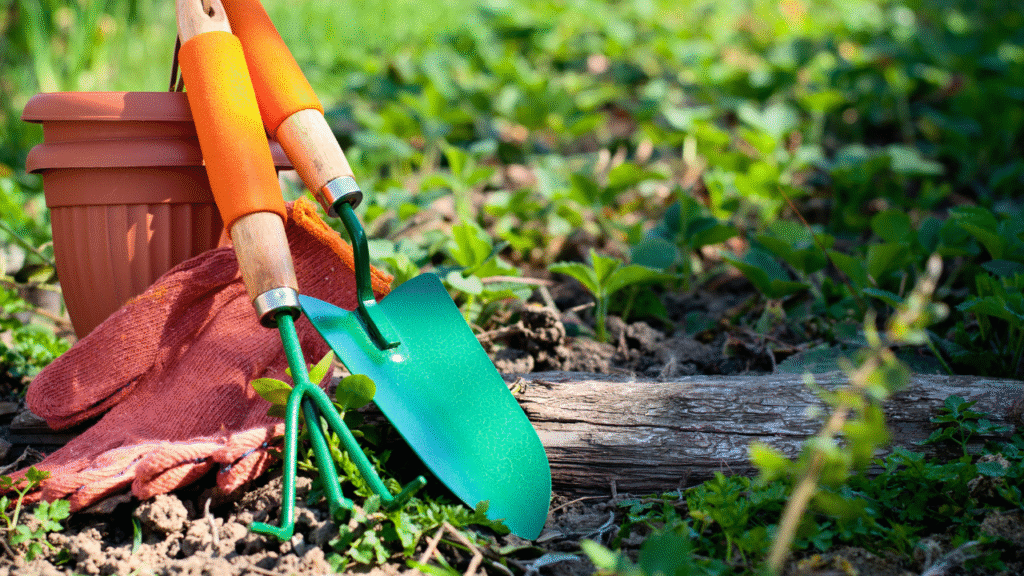
Maintenance Tips for Healthy Carpet Grass
Maintaining a lush, green carpet grass lawn isn’t just about watering it’s about consistent care and smart practices. If you follow these tips, your lawn will stay soft, dense, and beautiful all year round.
Mowing Techniques
Mowing is more than just keeping your grass short it directly affects growth, health, and resilience.
- Keep blades at the recommended height for your grass variety: Each grass type has an ideal height range. For example, Bermuda grass does well at 1–2 inches, while Zoysia can tolerate 1.5–2.5 inches. Cutting too short can stress the grass, make it more prone to weeds, and damage its root system. Think of it like giving your lawn a haircut that actually helps it grow stronger.
- Avoid cutting more than one-third of the blade at a time: Cutting more than this can shock the grass, slow growth, and leave it vulnerable to diseases. Regular mowing, following this rule, keeps your lawn dense and uniform, while also encouraging deeper root growth, which improves drought tolerance.
- Sharpen mower blades regularly: Dull blades tear grass instead of cutting it cleanly, causing brown tips and increasing vulnerability to pests and diseases.
Weed Control
Weeds are the enemy of a thick, healthy carpet grass lawn they compete for water, nutrients, and sunlight.
- Regular inspection: Walk your lawn every week to spot weeds early. Removing them while small prevents them from spreading.
- Selective herbicides: If weeds persist, use targeted herbicides that only affect unwanted plants and not your grass. Always follow instructions carefully.
- Preventive measures: Maintaining proper mowing height, watering, and fertilization creates a dense lawn that naturally crowds out most weeds. Think of your healthy grass as a shield against intruders.
Pest Management
Even the best lawn can face pests like grubs, caterpillars, or aphids. Healthy carpet grass is naturally resilient, but sometimes intervention is needed.
- Natural methods: Encourage beneficial insects like ladybugs or use neem oil sprays. Companion plants around the lawn can also repel certain pests.
- Chemical treatments: For severe infestations, use pesticides carefully, targeting only the affected areas. Overuse can harm your grass and the environment.
- Prevention is key: Avoid overwatering and overfertilizing, as these conditions attract pests. A well-maintained lawn is much less appealing to bugs.
Seasonal Care Tips
Caring for carpet grass changes with the seasons. Knowing what to do each season ensures your lawn stays healthy all year.
- Spring: This is the time for growth. Fertilize with a nitrogen-rich fertilizer to boost greening, and overseed any bare patches to maintain uniform coverage. Aerate compacted soil to allow roots to breathe.
- Summer: During hot months, your grass may face drought stress. Water deeply but less frequently to encourage deep root growth. Mow regularly to keep the lawn looking tidy, but never remove too much at once.
- Monsoon (if applicable): Heavy rains can cause waterlogging and fungal growth. Ensure proper drainage and avoid overwatering. Consider fungicide treatments if you notice signs of disease.
- Winter: Growth slows down in cold months. Reduce watering since the grass uses less water. Protect frost-sensitive varieties by covering young or delicate areas if needed. Avoid heavy foot traffic to prevent damage when grass is dormant.
Extra Tips for a Healthy Lawn
- Aeration: Periodically aerate your lawn to improve soil structure and allow nutrients to reach the roots.
- Topdressing: Apply a thin layer of compost or soil to improve soil health and maintain an even surface.
- Mulching: Leave grass clippings on the lawn to return nutrients naturally.

Common Mistakes to Avoid When Growing Carpet Grass
Overwatering or Underwatering
Water is life for grass but too much or too little can quickly ruin your lawn. Overwatering saturates the soil, which prevents oxygen from reaching the roots. This can lead to root rot, fungal infections, and yellowing grass. On the other hand, underwatering causes dry patches, slow growth, and weak roots that can’t support healthy blades.
How to avoid this:
- Water early in the morning to minimize evaporation.
- Check the soil’s moisture by inserting your finger about an inch deep; if it feels dry, it’s a sign your grass needs watering.
- Use a sprinkler system or drip irrigation to provide consistent, even watering.
- Adjust watering frequency based on the season; lawns need more water in summer and less in winter.
Ignoring Soil Quality
Even the best grass variety will struggle to grow in poor or compacted soil. Soil that lacks nutrients, has a wrong pH level, or has poor drainage can lead to patchy lawns, stunted growth, and increased vulnerability to pests and diseases.
How to avoid this:
- Test your soil before planting to determine pH, nutrient levels, and texture.
- Add organic matter, like compost or well-rotted manure, to improve fertility.
- Loosen compacted soil with a garden fork or rototiller to allow roots to grow freely.
- Ensure good drainage to prevent waterlogging, especially in heavy clay soils.
Skipping Fertilization
Grass needs nutrients to stay green, thick, and healthy. Skipping fertilization is one of the most common mistakes for homeowners. Without nutrients like nitrogen, phosphorus, and potassium, your carpet grass may become thin, pale, and weak, making it more susceptible to weeds and diseases.
How to avoid this:
- Use a balanced lawn fertilizer suitable for your grass variety.
- Apply fertilizer every 6-8 weeks during the growing season.
- Avoid over-fertilizing, which can burn the grass and pollute nearby water sources.
- Consider slow-release fertilizers for consistent nutrient supply.
Choosing the Wrong Grass Variety for Your Climate
Planting a sun-loving grass in a shaded area or a cold-tolerant grass in a tropical region is a recipe for failure. The grass may grow slowly, develop bare patches, or require extra maintenance to survive conditions it isn’t adapted to.
How to avoid this:
- Research your local climate and sunlight patterns before selecting a grass variety.
- For hot and sunny areas, choose drought-tolerant grasses like Bermuda or Buffalo Grass.
- For shaded areas, consider St. Augustine or Zoysia, which tolerate less sunlight.
- Match the grass to soil type, rainfall, and maintenance capacity to ensure long-term success.
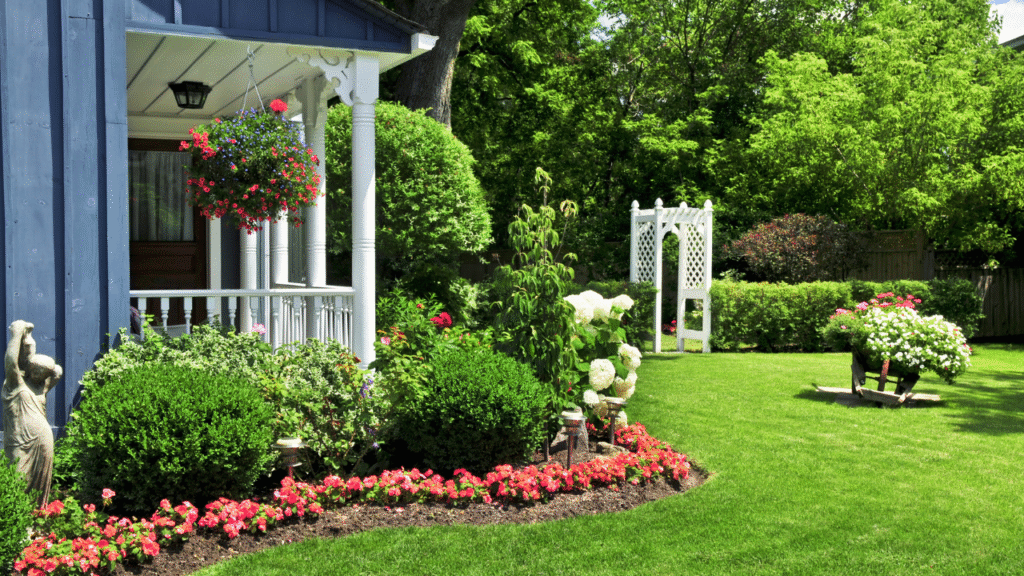
Environmental and Recreational Benefits of Carpet Grass
- Reduces soil erosion: Thick roots hold soil in place
- Safe play area: Soft, cushioned surface for kids and pets
- Lowers urban heat: Grass cools the environment naturally
- Improves air quality: Captures dust and pollutants, producing oxygen
Conclusion
Choosing the right carpet grass is more than just picking a green patch for your outdoor space it’s about creating a comfortable, beautiful, and sustainable environment. A well-chosen grass variety can completely transform an ordinary lawn, park, or playground into a lush, inviting, and vibrant area where people love to spend time.
Each grass type from Bermuda and Zoysia to Buffalo, Kikuyu, Perennial Ryegrass, and St. Augustine has its unique qualities. Some are fast-growing and resilient, ideal for heavy foot traffic, while others are soft and low-maintenance, perfect for family lawns or shaded areas. Understanding the strengths and weaknesses of each variety helps you select the best match for your climate, sunlight conditions, soil type, and intended use.
It’s also important to consider your maintenance capacity. Some grasses require regular watering, mowing, and fertilization, while others thrive with minimal care. Matching your lifestyle and resources with the grass’s requirements ensures that your lawn stays healthy without unnecessary stress or effort.
With proper planting techniques, consistent care, and attention to factors like watering, fertilization, and pest management, your carpet grass can remain green, dense, and soft throughout the year. This not only enhances the beauty of your outdoor spaces but also improves the environment by reducing dust, lowering heat, preventing soil erosion, and providing a safe area for children and pets to play.
In short, investing time and thought into choosing and caring for the right carpet grass pays off with a durable, eco-friendly, and visually stunning lawn, park, or playground that everyone can enjoy for years to come.
FAQs
- Which carpet grass is best for heavy foot traffic?
Bermuda and Kikuyu grasses are excellent for areas with heavy foot traffic because they recover quickly from wear and tear. - Can carpet grass survive in shaded areas?
Yes, St. Augustine grass tolerates moderate shade, while Bermuda and Zoysia prefer full sun. - How long does it take for carpet grass to fully establish?
It depends on the variety. Fast-growing types like Bermuda can establish in 6-8 weeks, while slower growers like Zoysia may take several months. - Is carpet grass suitable for pets?
Absolutely! Most carpet grasses are pet-friendly, though heavy use may require occasional overseeding. - How often should I fertilize my carpet grass lawn?
A general guideline is every 6-8 weeks during the growing season, adjusting for soil quality and climate.
